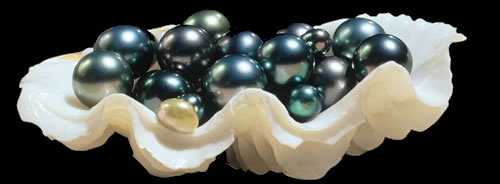Luster
Always look for luster first when selecting a Black Pearl. The luster
or reflective surface shine is the highly mirror-like quality. The
better the luster the higher the quality pearl, because the luster
indicates a thick layering of pearl material or nacre. Usually this
means the pearl has been in the oyster a long time. The thicker the
pearl nacre, the better the pearl.
Size
Size is one of the most important criteria for evaluating black pearls.
Since the Black Lipped Oyster is one of the largest oysters in the
world, the peals can also be of exceptional size. The size may average
8-10.5mm, or in some cases 11-14mm. The size is affected by the nucleus
and the nacreous layer secreted around it, as well as the size and
health of the oyster. The largest Black Pearl we have ever seen was
23mm, the size of a small bird egg! Size is only one of the factors
used to grade black pearls. Each pearl is evaluated individually using
all six criteria
Shape
Black Pearls come in a wide range of natural shapes ranging from pear-shaped,
tear-drop, button, mushroom, acorn, barrel, and baroque shapes. All
the shapes of black pearls are considered desirable and marketable.
Often, the pear-shaped and baroque pearls are set in pendant designs,
and the rounder pearls are used for rings and earrings. Round pearls
are harder for the oyster to create and therefore they are more rare
and more expensive.
Orient
The Orient is the heart and soul of the pearl. The Orient is defined
as the way the pearl reflects and decomposes light through aragonite
crystals. The Orient is the play of light penetrating the surface,
the depth of color and light that can be observed by looking past the
reflective lustrous surface and into the many layers of pearl material
or nacre. Each layer reflects light and creates the illuminating glow
reflecting light from within the pearl. The best way to observe orient
is to hold the pearl in front of a neutral background such as a white
shell. As light shines into the pearl, the eye is able to see past
the surface color and to the colors of each layer of nacre that surrounds
the pearl.
Color
Tahitian Black Pearls come in a rainbow of beautiful natural colors.
Each color is special, and each is sought after by collectors. The
most important factor in selecting color is to determine which color
looks best on the wearer. The colors comes alive on different skin
tones and complexions. All pearls have an under-color ranging from
pale silver to dark black. Often, there will also be a layering of
iridescent hues in addition to the under color. These shimmering colors
can be peach, copper, pink, sea green, turquoise blue, peacock green,
burgundy and bordeaux, indigo and navy, purple and lavender to canary
and cranberry to deep midnight black.
Surface
The outer skin of the pearl may be analyzed for smoothness and perfection
to determine the "beauty-marks" or imperfections of the pearl.
Every pearl will have some tiny "surface marks" which add to
the character and personality of each pearl. Most birthmarks are imperceptible
to the naked eye and give the pearl character. The beauty marks help
to determine if the pearl is "real", i.e. a natural color
natural shape cultured gem. Simulated pearls, Faux pearls and beads
will have a perfectly smooth surface.

|

|


